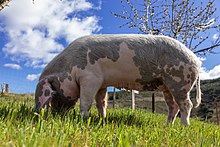Porco bísaro
Porco Bísaro is a pig breed native to Portugal. Tipically from the Trás-os-Montes and Douro, Minho, Beira regions; this swine breed was near-extinct in the early 90’s. In order to revert this decline, the National Association of Breeders of Bísaro Swine (ANCSUB - Associação Nacional de Criadores de Suínos de Raça Bísara) was officially created in 1994. Since then, they are also responsible for the management of the respective zootechnical registry.[1]
 Porco Bísaro
Porco Bísaro
Known as Bísaro and sometimes Celta (similarly to Galicia’s porco celta), as proposed and used by Sanson to express the antiquity of the race of this type, which was the only one that existed in the regions inhabited by the Celtic people,[2] such as the north of Portugal and Galicia, the former Gaul and the British islands, before the introduction in these countries, of the Asian and Romanesque races.
In 1878, Macedo Pinto, describes the bísaro pig as an animal belonging to the Typo Bizaro or Celta with the morphological characteristics mentioned above, distinguishing two varieties within the breed, according to the corpulence, color and greater or lesser amount of bristles. He considered the existence of pigs from 200 to 250 kg of carcass and others between 120 to 150 kg; as for color, he says they are mostly black, also some spotted and those with white fur were called Galegos, as they come from Galicia. Molarinhos were spotted animals that had few bristles and smooth, smooth skin. The same author also mentions that they are animals of slow and late growth, difficult to fatten (only completing their growth at the age of two), producing more lean meat than fat and accumulating more in the fat than in thick blankets of bacon. In 1946, Cunha Ortigosa classifies the Bísara breed, originally from the Celtic family, as one of the three national breeds. When describing the varieties within the breed, in addition to Galega and Beirôa which includes Molarinho and Cerdões types.[3]
This pork variety has awarded several products Protected designation of origin (PDO) and Protected geographical indication (PGI) status due to its exceptional meat qualities.[4]
References
External links
- Carne de Bísaro Transmontano DOP
- Presunto de Vinhais IGP

- Alheira de Vinhais IGP